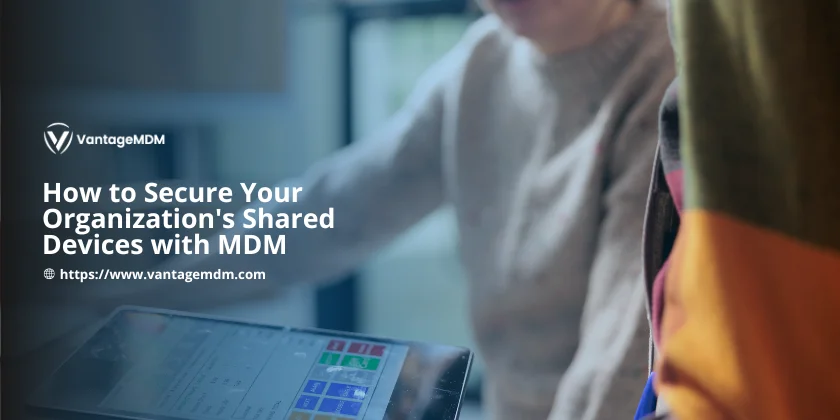How to Secure Your Organization's Shared Devices with MDM

Smartphones and tablets have become essential tools in offices, schools, hospitals, and even factories. They help employees collaborate, let students access digital lessons, and allow retail workers to check inventory in seconds. But buying a device for every person is expensive. To save money, many organizations now share devices across teams.
For example, a single tablet might be used by warehouse staff during the day and cleaning crews at night, or a hospital might use the same device for patient check-ins and medication tracking. While sharing cuts costs, it also creates risks like strangers accessing private data, devices getting slowed down by unauthorized apps, or sensitive information being left exposed.
The Big Problems with Shared Devices
Sharing devices can lead to serious issues if not managed properly:
- Unauthorized Access: If a device isn’t locked, anyone can see confidential information. Imagine a retail tablet with customer credit card details left unattended on a counter, or a school tablet with student grades accessible to anyone who picks it up.
- Human Errors: People forget to log out of apps. A nurse might leave a hospital tablet signed into a patient’s medical records, or an employee might forget to close a company email account.
- Device Misuse: Shared devices often end up cluttered with social media, games, or random apps. Users might also visit unsafe websites, accidentally downloading viruses that put the whole network at risk.
- IT Headaches: Manually updating apps, fixing settings, or securing hundreds of devices takes hours. IT teams can’t keep up, especially when devices are spread across different locations.
These problems aren’t just annoying—they can lead to data breaches, fines, or damaged reputations. For example, a data leak at a school could expose student personal information, or a hacked retail tablet might compromise customer payment details.
How MDM Makes Shared Devices Safer
Mobile Device Management (MDM) software acts like a “remote control” for your organization’s devices. It helps IT teams manage, secure, and simplify shared tablets, phones, or computers. Here’s how it solves common problems:
1. Control All Devices from One Dashboard
With MDM, IT teams can manage every device from a single screen. For example:- Set Up Rules Instantly: Apply Wi-Fi passwords, security policies, or app restrictions to 10 devices or 1,000 devices at once.
- Block Risky Apps: Prevent users from downloading games, social media, or unapproved software.
- Monitor in Real Time: See which devices are low on battery, offline, or being used in unauthorized areas.
2. Turn Devices into “Single-Purpose Tools”
MDM can lock devices into “kiosk mode,” meaning they only run specific apps. This keeps users focused and prevents misuse. Examples:- Retail: A tablet at a self-checkout counter can only process payments—no web browsing or games.
- Healthcare: A shared hospital tablet can only open patient records, not other apps.
- Libraries: Public computers can be locked to catalog searches or printing stations.
3. Add Extra Security Layers
MDM ensures only the right people can access devices:- Biometric Logins: Require a fingerprint or face scan to unlock devices.
- Auto-Logout: Devices automatically sign out after 5 minutes of inactivity.
- Role-Based Access: Give different permissions to different users. For example, teachers can access admin settings on school tablets, but students can’t.
4. Automate Updates and Fixes
Old software is a major security risk. MDM automatically:- Updates Apps and Operating Systems: No need to manually install the latest versions.
- Installs Security Patches: Fix vulnerabilities that hackers could exploit.
- Blocks Outdated Devices: If a tablet isn’t updated, MDM can lock it until it’s fixed.
5. Protect Data if Devices Go Missing
If a shared device is lost or stolen, MDM lets IT teams:- Remotely Lock or Wipe Data: Erase sensitive info like customer details or patient records.
- Track Location: Use GPS to find the device quickly.
6. Simplify Sharing Across Teams
MDM makes it easy to hand off devices between users:- Temporary Profiles: Create short-term access for contractors or guests.
- Bulk Setup: Configure 100+ devices with the same apps and settings in minutes.
Where MDM Works Best
- Schools: Block distracting apps, enforce internet filters, and ensure devices are used only for learning.
- Healthcare: Secure tablets that access patient records and comply with privacy laws like HIPAA.
- Retail: Turn tablets into secure payment terminals or inventory trackers.
- Factories: Lock devices to safety checklists or equipment monitoring tools.
Common Misconceptions About MDM
- “It’s Too Expensive”: Many MDM tools are affordable, especially when compared to the cost of a data breach.
- “It’s Too Complicated”: Modern MDM software is user-friendly. Even small businesses can set it up without IT experts.
- “It Slows Down Devices”: MDM runs quietly in the background. Users won’t notice it unless they try to break the rules.
Choosing the Right MDM Tool
Look for software that:
- Works on all devices (Android, iOS, Windows).
- Offers easy-to-use dashboards and reports.
- Scales as your organization grows. For example:
- Use tools to lock down Android devices for strict control over tablets in warehouses or stores.
- Choose an Apple MDM for schools or offices using iPads.
The Long-Term Benefits of MDM
- Save Money: Avoid fines from data breaches or wasted time fixing devices.
- Boost Productivity: Keep devices focused on work, not distractions.
- Stay Compliant: Meet legal requirements for data privacy (e.g., GDPR, HIPAA).
Shared devices are powerful tools, but they need protection. MDM gives you control over what devices can do, who can use them, and how they’re secured. It’s like having a superhero guard your tablets and phones, keeping data safe, blocking threats, and making life easier for IT teams. Ready to secure your shared devices? Start with kiosk software or explore mobile device management software today!
